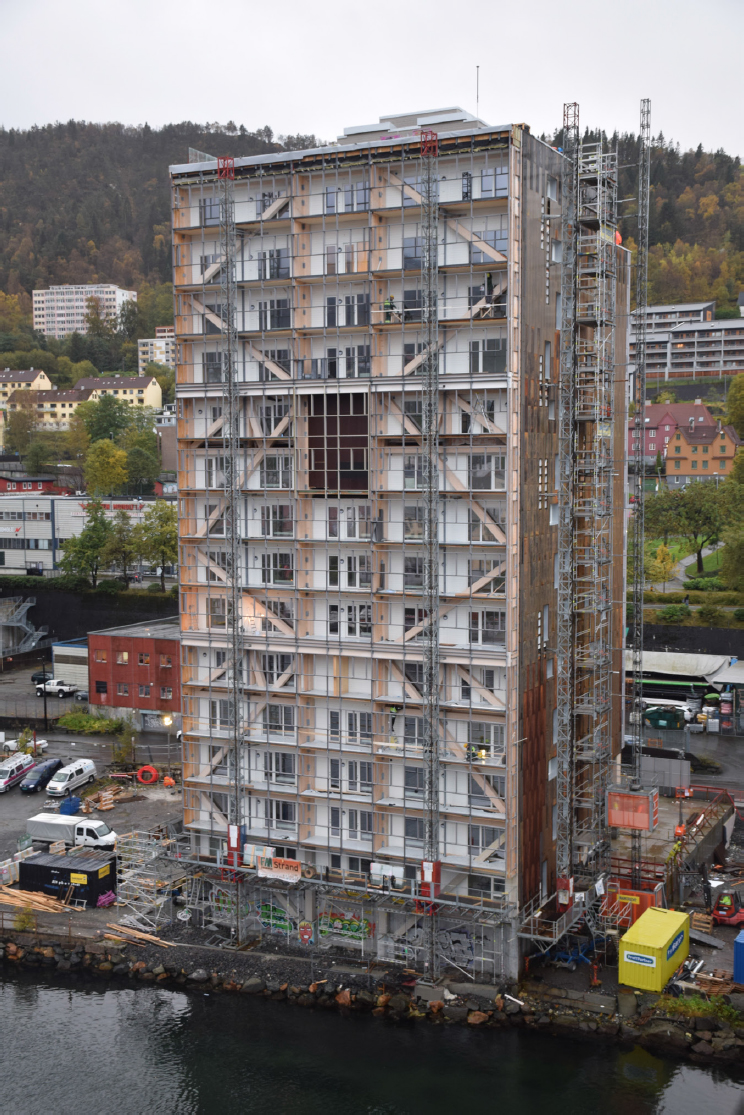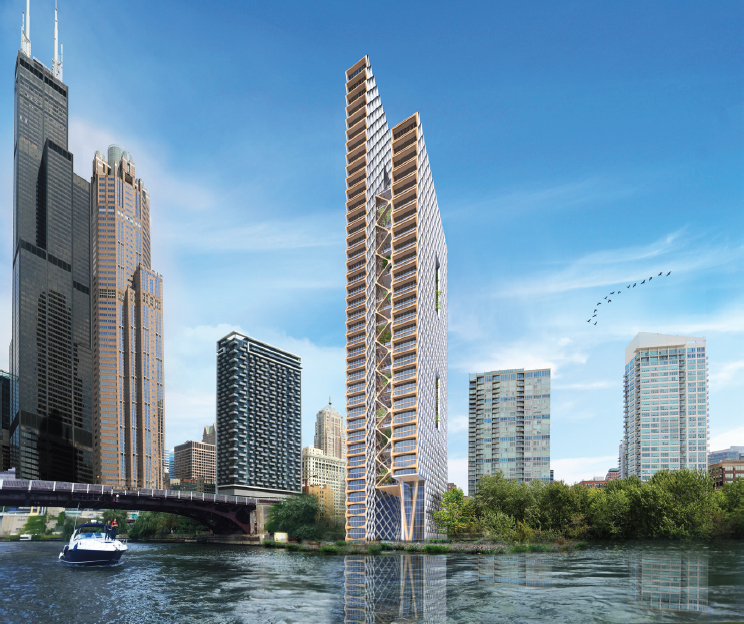Supertall Timber: Functional Natural Materials for High-Rise Structures
MICHAEL H. RAMAGE
University of Cambridge
Wood and wood products have been used as building materials since before recorded history, but the full potential of timber and other plants as building materials has not yet been realized.
Engineered timber materials, among them cross-laminated timber (CLT) and laminated veneer lumber (LVL), have enabled architects and engineers to design and build larger and larger timber buildings. The tallest is Brock Commons, a 55-meter, 18-story student dormitory completed in 2016 at the University of British Columbia. Before that, the tallest was Treet (“tree” in Norwegian), a 53-meter, 14-story condominium completed in 2015 in Bergen, Norway (Figure 1). Brock Commons has two concrete cores, while Treet is a fully timber structure, so each may be the tallest of its type (Foster et al. 2016).
The scale of these contemporary buildings is significant, as the first metal-framed skyscraper, William Le Baron Jenney’s Home Insurance Building in Chicago, was 55 meters tall when completed in 1891, and 1931 saw the completion of the Empire State Building in New York City, at 381 meters.
Innovation in natural materials, design, and construction may allow a similar increase in the height of timber skyscrapers. And the use of natural materials instead of steel and concrete in taller and larger buildings can reduce carbon emissions. Furthermore, CLT construction requires only about 30 m3 for an apartment for two people. Using wood from only 30 percent of Europe’s managed forests with current practices, the entire population of Europe could be housed in perpetuity, even assuming the entire housing stock was renewed every 50 years (Ramage et al. 2017a).

BACKGROUND
Timber has exceptional properties for building, many of which have been overlooked in the construction of ever-taller buildings in the past century. Advances in biological knowledge, engineering of plant-based materials, and interest in renewable construction are converging to create new possibilities for materials and allow for larger, taller, and more natural engineered wood buildings (Green 2012; Ramage et al. 2017a).1
There is also competition in the building industry to construct the tallest timber tower. Height increases are currently incremental, but through a combination of theoretical design and physical testing, the viability of timber buildings can be demonstrated at much greater heights than previously possible (Ramage et al. 2017b).
By pushing the limits of theoretical designs into the realm of the supertall2—and sometimes beyond that which is feasible using current materials and construction technologies—our research sets out the requirements for the next generation of engineered plant-based materials. Research and the design and construction of contemporary large-scale timber buildings together further the architectural and structural engineering knowledge necessary to make tall timber buildings a reality.
Materials science has advanced the industrial production of steel and reinforced concrete since the mid-19th century. The materials science of natural materials is less well understood, but the use of biofuels has helped drive fundamental research on the makeup of plant cells and their constituent parts.
Improved information about how to break down plants into useful components can also enhance understanding of their underlying properties. As an example, the model plant Arabidopsis thaliana, whose genome is well defined and editable, is essentially the mouse of plant science. Through biochemistry, it can be grown with lignin-depleted cells for studies of the role of lignin in giving plant cells their characteristic properties. In Arabidopsis, lignin appears to help control the way cells move past each other as they are pulled apart in tensile tests.
With better knowledge of how the elements of cell walls contribute to the properties of plants and forest products, it may be possible to breed or genetically engineer plants with specific functional properties that are more favorable to construction.
CURRENT DEVELOPMENTS AND APPLICATIONS
Novel properties in trees may give rise to a new class of natural materials, but engineered timber products on the market are already giving designers around the
___________________
1 Also see the 2013 technical report of the SOM Timber Tower Research Project, available at http://www.som.com/ideas/research/timber_tower_research_project.
2 Supertall buildings are 300–600 meters. For reference, the original 110-floor World Trade Towers in New York were just over 540 meters, and the Sears Tower in Chicago is 442 meters.
world opportunities to innovate with large-scale construction. CLT can be used much like slabs of concrete in walls and floors, and glue-laminated timber and LVL can substitute for steel or concrete columns and beams. All can be used with existing modes of construction.
But there are limitations. For example, platform construction with CLT is limited by the perpendicular-to-grain crushing of panels at floor junctions, a phenomenon that is difficult to overcome above 10 stories or so. And although the axial strength of some hardwood LVL in compression and tension is sufficient to engineer very large buildings, the ability to transfer tensile loads that can be carried by the full section from one element of timber to another remains to be determined.
Our supertall timber project, in which we have designed wooden skyscrapers (Figure 2), shows the viability of commercial and residential buildings at a new scale in timber, using components and materials that are commercially available

today. Our design and research demonstrate the architectural, engineering, and economic possibilities that stem from thinking about traditional materials in new ways.
OTHER PLANTS
A variety of plants may add to the materials available. Bamboo has excellent properties in tension and compression, and is among the world’s fastest growing plants—it can be harvested every few years. In addition, a number of processing methods exist to turn the raw product into an engineered material (Sharma et al. 2015), and more are being developed. Engineered bamboo looks like wood and is crafted with woodworking equipment. It behaves differently as a structural material (Reynolds et al. 2016), so new engineering codes are necessary.
Other crops, such as flax and hemp, are being used to make structural composites for automotive and industrial design and at the same time engineered to deliver improved properties. All of these crops are available at a scale necessary for construction.
ADVANTAGES
Construction with timber has many advantages, not least for the environment.
- Timber is the only major building material that can be grown, and the sustainable harvest of lumber is vast—crop-planted forests around the world are expanding.
- Timber is five times lighter than concrete, so to construct an equivalent volume of building, only one timber truckload is needed, as compared to five concrete mixers.
- No formwork needs to be brought to site (and removed) and no reinforcing steel is necessary. The steel in timber connections is negligible. We roughly redesigned the Treet building in reinforced concrete for comparison and discovered that it would have five times as much steel in it as the timber building.
- The savings multiplier on construction truck traffic can be as high as eight.3 These savings have implications for today’s crowded metropolises: smaller foundations, or indeed no new ones, as the existing foundation for a demolished 10-story concrete building can hold a timber building three to four times as tall, with quieter construction and smaller cranes.
- Contemporary timber buildings are largely prefabricated for component assembly, meaning they are quick to erect accurately on site and tend
___________________
3 Personal communication February 2, 2017, with Ralph Austin of Seagate Structures, which has built a number of large-scale timber buildings in Vancouver.
to be naturally draft-proof and efficient, saving time and energy and improving overall quality.
CONCLUSION
As manufacturers, architects, engineers, and contractors learn to expand what they can do with large-scale engineered timber, a new architecture of 21st century timber will arise, drawing on a rich tradition of centuries of wooden construction while reaching higher to embrace the full potential of innovation and construction with natural materials.
ACKNOWLEDGMENT
This research is supported by EPSRC Grant EP/M01679X/1 and by a Leverhulme Trust Programme Grant.
REFERENCES
Foster RM, Reynolds TPS, Ramage MH. 2016. Proposal for defining a tall timber building. Journal of Structural Engineering 142(12):1943–1954.
Green M. 2012. The Case for Tall Wood Buildings. http://cwc.ca/wp-content/uploads/publications-Tall-Wood.pdf.
Ramage MH, Burridge H, Busse-Wicher M, Fereday G, Reynolds T, Shah DU, Wu G, Yu L, Fleming RP, Densley-Tingley D, and 4 others. 2017a. The wood from the trees: The use of timber in construction. Renewable and Sustainable Energy Reviews 68(1):333–359.
Ramage MH, Foster RM, Smith S, Flanagan K, Bakker R. 2017b. Super tall timber: Design research for the next generation of natural structure. Journal of Architecture 22(1):104–122.
Reynolds T, Sharma B, Harries K, Ramage M. 2016. Dowelled structural connections in laminated bamboo and timber. Composites Part B: Engineering 90:232–240.
Sharma B, Gatóo A, Bock M, Ramage MH. 2015. Engineered bamboo for structural applications. Journal of Construction and Building Materials 81:66–73.






